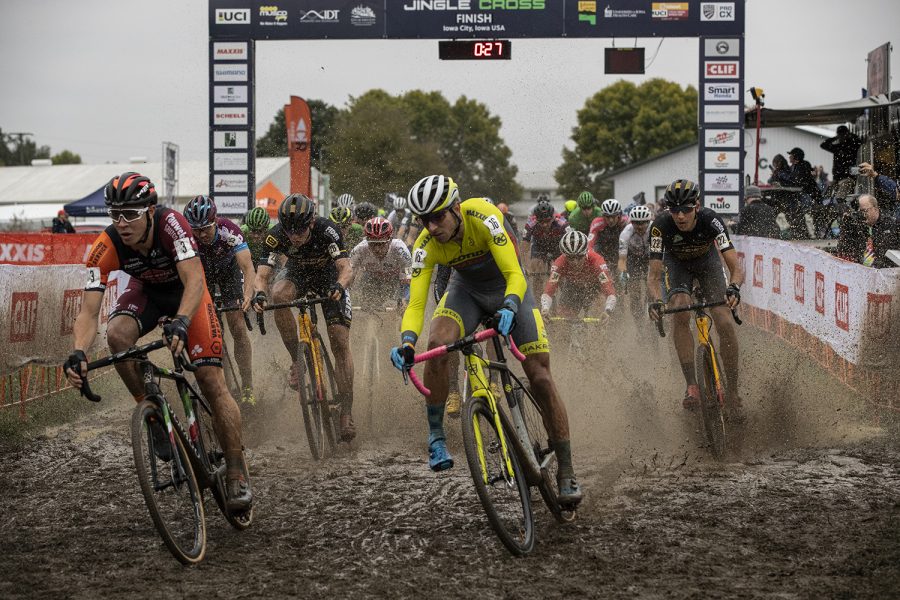Cyclocross (CX) is a form of bicycle racing that combines elements of road cycling, mountain biking, and cross-country running. Races typically occur in autumn and winter (September to February in the Northern Hemisphere) on short, technical courses (2.5–3.5 km or 1.5–2 miles) featuring varied terrain like pavement, grass, mud, sand, steep hills, and obstacles. Riders must dismount and carry their bikes over barriers or unrideable sections, making it a test of endurance, bike-handling skills, and agility. Races last 40–60 minutes for senior categories, with laps completed within that time.
Cyclocross bikes resemble road bikes but have wider tire clearances, knobby tires for traction, and cantilever or disc brakes for muddy conditions. They’re lightweight (around 20 pounds) to facilitate carrying and feature lower gearing for steep climbs. The sport originated in Europe in the early 20th century as a way for road cyclists to stay fit in the off-season, with Belgium, France, and the Netherlands as traditional strongholds. It has since gained global traction, particularly in the U.S. since the 1970s.
Why is Cyclocross Popular in the Global Sports Market?
Cyclocross’s rising popularity in the global sports market, while still niche compared to sports like soccer (4 billion fans) or cycling’s road racing (Tour de France’s global viewership), stems from several factors:
- Accessibility and Community:
- Cyclocross is inclusive, with races for all ages, skill levels, and genders, often on the same day. Amateur and elite races coexist, fostering a tight-knit community where beginners can compete alongside pros. This contrasts with road cycling’s more exclusive professional scene.
- Low entry barriers—races don’t require expensive bikes (a used CX bike costs ~USD 500–1,000)—make it approachable. Many use modified road or mountain bikes initially.
- Spectator Appeal:
- Short, action-packed races on looped courses are spectator-friendly, with fans cheering close to the action. Muddy crashes, daring descents, and dramatic dismounts create excitement, amplified by social media highlights.
- The festive atmosphere, with beer tents, cowbells, and costumes (especially in Belgium), draws crowds, boosting local economies and media coverage.
- Seasonal and Cultural Fit:
- As a winter sport, cyclocross fills a gap in the cycling calendar, offering off-season training for road cyclists and a unique challenge for mountain bikers. Its gritty, cold-weather vibe resonates in cycling strongholds like Flanders, where it’s a cultural institution.
- In the U.S., its growth since the 1990s (e.g., Surf City series in Santa Cruz) aligns with the rise of outdoor adventure sports and fitness trends.
- Global Expansion:
- The sport’s spread beyond Europe, particularly to North America and Asia, fuels market growth. The U.S. hosts over 1,000 cyclocross events annually, with participation rising steadily. Japan and Canada also have growing scenes.
- The global sports events market, valued at USD 266 billion in 2023 with a projected 7.5% CAGR to 2032, benefits from niche sports like cyclocross attracting dedicated fans and sponsors.
- Technological and Media Boost:
- Advances in bike technology (e.g., carbon fiber frames, tubeless tires) and sports tech (e.g., GPS, power meters) enhance performance and fan engagement. Live streaming and social media amplify visibility, with platforms like FloBikes covering major races.
- Sponsorships from brands like Trek and Specialized, part of the USD 115 billion sports sponsorship market (projected to hit USD 160 billion by 2030), drive investment.
- Health and Environmental Trends:
- Cyclocross aligns with growing health consciousness, offering a high-intensity workout (burning ~600–800 calories/hour). Its outdoor, eco-friendly nature appeals to environmentally conscious consumers, especially in Europe, where cycling infrastructure investments (e.g., Tartu’s EUR 10 million bike roads) support the sport.
Despite its appeal, cyclocross remains less mainstream than road cycling due to its seasonal nature, smaller media deals, and limited Olympic status (though UCI pushes for 2030 Winter Olympics inclusion). Its market share is constrained by high bike maintenance costs and weather-dependent participation, but its passionate fanbase and growth potential sustain its niche prominence.
Important Global Cyclocross Events
- Held annually in late January, this is the sport’s pinnacle, crowning world champions in elite, U23, and junior categories. Recent hosts include Fayetteville, USA (2022), and Liévin, France (2025).
- Stars like Mathieu van der Poel (Netherlands) and Fem van Empel (Netherlands) dominate, drawing global attention.
- A season-long series (October–February) with 12–14 races across Europe, the U.S., and occasionally Asia. Key events include Namur (Belgium) and Val di Sole (Italy, a snow-covered course). It’s the premier stage for elite riders and Olympic hopefuls.
- The 2021 Val di Sole race tested Winter Olympics feasibility.
- European series (mostly Belgium) known for iconic races like Zonhoven and Koksijde. These attract top talent and massive crowds, with live broadcasts boosting viewership.
- A key American series, alongside events like Charm City Cross and Jingle Cross, showcasing U.S. growth. The U.S. National Championships (January) crown domestic champions.
- Held in countries like Belgium, Netherlands, France, USA (January), and Canada (November), these are critical for regional pride and World Championship qualification.
These events contribute to the sports events market’s growth, driven by rising viewership, digital streaming, and sponsorships.
How to Get Started in Cyclocross and Become Your Best
Getting Started (Young or Old)
- Join a Local Club or Community:
- Find a cyclocross or cycling club through national federations like USA Cycling, Cycling Canada, or the UCI (uci.org). Clubs offer beginner clinics, often in fall, teaching dismounts, remounts, and cornering.
- In the U.S., local series like Cross Crusade (Portland) or Chicago Cross Cup welcome newcomers. In Europe, Belgian clubs are accessible even for kids.
- Get a Bike:
- A cyclocross-specific bike is ideal (USD 1,000–3,000 new, ~USD 500 used), but beginners can modify a road bike with knobby tires or use a gravel bike. Key features: drop handlebars, 33–40mm tires, and disc brakes.
- Renting or borrowing is common at clinics. Avoid heavy hybrid bikes, as they’re hard to carry.
- Learn the Basics:
- Attend a cyclocross clinic or group ride to master skills like dismounting at speed, shouldering the bike, and navigating obstacles. YouTube tutorials
 (e.g., GCN’s cyclocross guides) are helpful.
(e.g., GCN’s cyclocross guides) are helpful. - Start with flat, grassy areas to practice cornering and off-camber turns. No prior cycling experience is needed, but basic fitness helps.
- Enter a Race:
- Sign up for a local race in the beginner (Category 4/5) or age-group category. Races are affordable (~USD 20–40) and inclusive, with kids’ events as short as 20 minutes.
- Check platforms like BikeReg.com (U.S.) or local federation websites for schedules. Most series run September–December.
- Gear Up:
- Wear cycling shorts, a jersey, and clipless pedals/shoes for efficiency. Helmets are mandatory. Gloves and warm layers suit cold, muddy conditions.
- Budget ~USD 200–300 for basic apparel; used gear is widely available.
https://www.youtube.com/@HPCyclocross
Becoming Good at Cyclocross
- Build Fitness and Skills:
- Endurance: Train with 1–2 hour rides, including intervals (e.g., 5×3 minutes at high intensity) to mimic race efforts. Cyclocross demands aerobic capacity and recovery.
- Bike Handling: Practice dismounts, remounts, and cornering on varied terrain. Set up a backyard course with cones or barriers. Join weekly club practices for drills.
- Strength: Off-bike workouts (e.g., running, squats, core exercises) improve carrying and climbing. Plyometrics enhance explosive power for remounts.
- Race Strategically:
- Start fast to avoid bottlenecks at the first corner. Pace yourself to maintain energy for 6–10 laps. Study the course beforehand to plan dismounts and passing zones.
- Learn from losses—analyze where you struggled (e.g., technical sections, fitness) and target those in training.
- Train Seasonally:
- Off-Season (Spring/Summer): Build base fitness with long road or gravel rides. Cross-train with running or swimming to prevent burnout.
- Pre-Season (August): Add cyclocross-specific drills and short, intense workouts. Join group rides to simulate race chaos.
- In-Season (Fall/Winter): Race weekly, using events as training. Recover with light spins or rest days midweek.
- Work with a Coach:
- A coach (USD 50–150/month) can design personalized plans, especially for juniors or masters (40+) aiming for nationals. Online platforms like TrainerRoad offer CX-specific programs.
- In Europe, clubs often provide free coaching for youth. In the U.S., seek USA Cycling-certified coaches.
- Leverage Technology:
- Use power meters or heart rate monitors to track intensity. Apps like Strava analyze rides and compare segments. Video your races to critique technique.
- Bike maintenance is key—clean and lube your drivetrain after muddy races to avoid wear. Learn to swap tires for different conditions (e.g., mud vs. dry).
- Compete and Progress:
- Move up categories (e.g., Cat 4 to Cat 3) as you gain points from top finishes. Aim for regional series podiums, then national championships or UCI races.
- Juniors can target Junior World Cups (age 17–18), while masters (40+) have thriving categories. Elite racers need UCI points for World Cup or World Championship selection.
- Overcome Challenges:
- Muddy crashes and bike issues are common—practice staying calm under pressure. Budget for repairs (e.g., tires ~USD 50 each) or seek team sponsorships.
- Cold weather and travel costs (USD 100–500/season) can deter some. Carpool with teammates or focus on local races to save money.
Young vs. Older Athletes
- Young Athletes: Kids as young as 6 can start with junior clinics using mountain bikes. Programs like USA Cycling’s Little Bella’s or Belgium’s youth academies emphasize fun and skills. Regular racing (e.g., 20–30 minute events) builds confidence. Parental support and affordable used bikes are key.
- Older Athletes: Adults (30+) or masters (40+) can begin with no prior experience, as cyclocross rewards grit over youth. Masters categories are competitive yet welcoming. Focus on injury prevention (e.g., stretching, strength training) and recovery, as older bodies fatigue faster. Shorter races suit busy schedules.
Critical Perspective
Cyclocross’s market growth is promising but faces hurdles. Its niche status limits mainstream sponsorship compared to road cycling’s Tour de France or soccer’s Premier League. The UCI’s push for Winter Olympics inclusion could elevate its profile, but logistical challenges (e.g., snow course consistency) remain. In the U.S., uneven regional development (strong in New England, weaker in the South) and a lack of affordable coaching hinder grassroots expansion. Globally, the sport’s European dominance may alienate emerging markets like Asia, where infrastructure lags. Addressing these—through subsidized youth programs, digital engagement, and diverse event locations—could unlock greater market share in the USD 862 billion sports industry.
Conclusion
Cyclocross is a thrilling, accessible sport blending cycling, running, and strategy, popular for its community, spectator appeal, and alignment with health and environmental trends. Major events like the UCI World Championships and World Cup drive its global presence, supported by a growing sports tech and sponsorship market. Beginners of any age can start with a local club, a modest bike, and a race entry, progressing through consistent training, racing, and technical skill-building. While its niche status and costs pose challenges, cyclocross’s passionate community and potential Olympic future signal sustained growth. Visit usacycling.org or uci.org for local clubs and race schedules to get rolling.















